George Held – Five Poems
“Dolce far niente”
the old professor mused,
and offered no definition:
“It’s Italian and untranslatable
into American – we have
no comprehension of such
a state,” he said as he sipped
his sherry. He was a lover
Of Whitman’s “I loaf
and invite my soul.”
“Can you imagine,” he asked,
“Old Walt, queer as a $3 bill,
proposing such blasphemy
to the blind but restive strivers
of the Republic?” The old prof
was himself professedly queer
but still in the closet,
by inclination a loner
and content with visits
from the few friends
who enjoyed his mellow
companionship.
Farewell, old friend,
I said at the bier:
May you reach the shores
of dolce far niente.
For EJK, R.I.P.
A Lame Doe
At dusk they come to my lawn,
two yearlings and a lame doe,
her right foreleg so sore
she can’t stand on it.
Undisturbed, they nibble buds
and graze on shoots, eating even
intolerable yucca.
If I startle them,
she shoos her young
to run along
while she limps
after them.
My neighbor reviles deer
as vermin and, worse,
traffic hazards
that could cause our death,
leaping into our path
to make our car
swerve into an oak.
“Shoot ’em on sight!”
she says. “We don’t want
their kind around here.”
The lame doe
and her two fawns
drift into the dark
like ghosts.
The Ache of Fall
I look up
from my computer
and out the window
and I see gold
and green leaves
mixed on the elm
across the street
and the Sophora
japonica trees
beyond.
Once the leaves fall
the Hudson
will again
be visible.
I feel the ache
of fall.
Desire
In Burne-Jones’s pencil drawing Desiderium,
the androgynous image of his Greek lover,
Maria, in profile, appears flushed, aroused,
her long neck a Pre-Raphaelite emblem.
In the Tate, the figure’s half-closed eyes seem
fixed on an unseen object of desire,
the sensuous full lips parted to admit it.
Only Hollyer’s photo of the whole piece,
Before it was trimmed to the right of her face,
Shows, faintly, her hand cupping a scrotum,
above which extends, almost touching her face,
the glans and shaft of an erect penis.
On Water Stone
Water emerging from depth of rock
slides
down all seven sides
of basalt sculpture,
“uniting
the disparate elements
of water and stone”
On one side a wood screen
with vertical slots
frames
Noguchi’s Water Stone
near the Edo exhibit
at the Met
uniting
fixed & fluid
painting & sculpture
ancient & modern
Author’s Statement on Beauty
Beauty is either fixed or fluid. If fixed—“a thing of beauty is a joy forever”—beauty might be part of the philosophy that there’s nothing new under the sun. Fixed beauty occurs in art, in scenic views, like the Grand Canyon or a sunset, and in classical notions of the human form. Fluidity complicates the idea(s) of beauty, for it implies a range of predilections, biases, and tastes: de gustibus non disputandum est. (How’s that for beauty—three clichés in the first four lines?) A fluid sense of beauty encourages the need to create, invent, explore something new “under the sun.” Today new concepts of beauty are under construction because of the fluidity of forms made possible by new technologies and techniques, even medical procedures to alter the face, the body, even gender. How do we recognize beauty in new forms?
Answering this question will prompt a lot of theorizing, debate, and dispute. Personally, I have no desire to formulate a definition of beauty, as my opening statement suggests: there are probably other categories of beauty than “fixed” or “fluid.” And I have generally had an eccentric reaction to conventional beauty while remaining skeptical of new notions of beauty. Even my poems in this issue vary in form, subject, length, and some readers might scratch their head and wonder about the editors’ choices. But I thank and respect the editors for their openmindedness toward what constitutes beauty in a poem. In general, can we agree on the eccentric (“out of the circle” of conformity) as part of beauty and crucial to the recognition of it?

George Held publishes regularly both online and in print, in such journals as Confrontation, Notre Dame Review, String Poet, and Xanadu. His work has been included in three dozen anthologies, and Garrison Keillor read one of George’s poems on A Writer’s Almanac. His recent books include Neighbors 3: The Water Critters (2015), animal poems for children, illustrated by Joung Un Kim, and Culling: New & Selected Nature Poems (2014), as well as the chapbooks Bleak Splendor (2015) and Phased II (2016). More at: georgeheld.blogspot.com.

